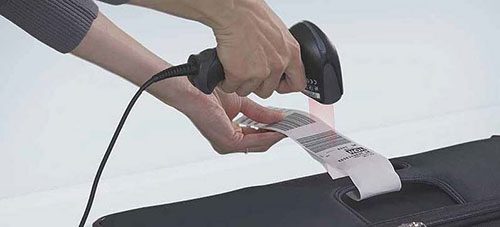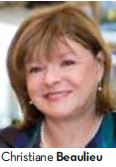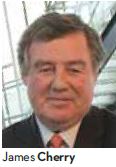
From automated teller machines for cash to scan-it-yourself checkout lanes at the supermarket, consumers are accustomed to self-serve options. Montréal-Pierre Elliott Trudeau International Airport (YUL) is giving air travelers just that.
|
factsfigures Project: Self-Service Technologies Location: Montréal–Pierre Elliott Trudeau Int’l Airport Airport Authority: Aéroports de Montréal Initiated: 2004 Offerings: Self-service common-use check-in; self-tagging of luggage; self-service baggage drop; Automated Border Clearance Self-Service Bag Drop System: Cofely Services Self-Service Bag Drop Pilot Partner: WestJet Airlines Benefits: Decreased wait times; improved passenger flow; reduced infrastructure needs |
"One day, it will be like going to the movies: You buy your ticket and then you just go and find your seat," predicts Christiane Beaulieu, vice president of public affairs and communications for Aéroports de Montréal.
 Like moviegoers, YUL patrons may choose to stop for concessions (including popcorn in both cases), but screening by the Canadian Air Transport Security Authority aside, passengers need little-to-no assistance from airport agents to get from Point A at Check-in to Point B in their aircraft seats.
Like moviegoers, YUL patrons may choose to stop for concessions (including popcorn in both cases), but screening by the Canadian Air Transport Security Authority aside, passengers need little-to-no assistance from airport agents to get from Point A at Check-in to Point B in their aircraft seats.
With self-service equipment for passenger check-in, baggage check-in, baggage drop and even clearing Customs (see sidebar on Page 21), YUL is fast approaching the cinema-like simplicity envisioned by the Montreal airports authority.
"Airlines and the industry as a whole are making the traditional check-in process as we know it disappear," says James Cherry, president and chief executive officer of Aéroports de Montréal.
"Passengers will be getting checked-in by default (via automated technologies) and airports, therefore, need to focus on common-use, rapid bag drop options, which is the part of the process that will remain at airports. This is why (we are) part of the leading airports in terms of common-use, generic and self-service bag drop processes."
In 2011, more than half of YUL's departing passengers bypassed traditional check-in counters. Of that group, 35% obtained boarding passes at a self-service kiosk, followed by 25% via the Internet and 2% by cellphone. Fully 73% of departing passengers who used a self-service kiosk did not need an agent's assistance to complete the check-in process, and competency rates are expected to rise even higher with time.
Making check-in a one-stop, short-queue experience is clearly a priority at YUL.
Evolving Airport Protocol
Known as a pioneer of self-service technology, Aéroports de Montréal has been on the cusp of emerging trends since 2004, when it first unveiled common-use check-in kiosks at YUL.
 "Aéroports de Montréal believes self-service is a trend that is here to stay," points out Cherry. "In our industry, as in many others, self-service allows the customer to take control, while at the same time improving flow and reducing infrastructure needs."
"Aéroports de Montréal believes self-service is a trend that is here to stay," points out Cherry. "In our industry, as in many others, self-service allows the customer to take control, while at the same time improving flow and reducing infrastructure needs."
Market research drives the authority's technology-centric changes. In the second quarter of 2012, 95% of passengers surveyed said they were satisfied with the ease of use at YUL's 148 self-service kiosks. In addition to automating the check-in process, all stations are equipped with a luggage-tag printer that allows passengers to tag their own checked bags.
Established in 2005, YUL was the first airport in the world to offer this feature in a common-use environment.
YUL braved new territory again in December 2011, when it became the first North American airport to offer self-service baggage drop. Aéroports de Montréal enlisted WestJet Airlines to participate in a pilot program that uses uDrop, a self-service baggage system from Cofely Services.
|
Automating Customs? Since the implementation of self-service check-in stations at Montréal–Pierre Elliott Trudeau International Airport (YUL) in 2004, officials at Aéroports de Montréal have seen evidence that the kiosks reduce wait times and improve passenger flow. They have also taken note of the floor space the passenger-driven technology frees up compared to traditional agent-manned counters. In a complimentary follow-up initiative, the airports authority recently debuted Automated Border Clearance. Known as ABC for short, the program is an attempt to reduce lines and ease congestion while increasing passenger satisfaction with Canadian Customs. In June 2012, 18 self-service kiosks were installed at YUL at a cost of $4 million (Canadian). Recent research shows that fully 60% of eligible passengers had used an ABC kiosk. And their feedback seems to bode well for the future of the program. A survey of 1,000 users found:
• 94.5% were satisfied with the overall automated process, including interaction • 87.8% said their wait time was shorter than any previous experience entering Canada, regardless of the airport • 94.1% said they would use a kiosk again |
"WestJet was already using the Cofely product in an agent-facing role to support our self-service baggage tagging product, and (the airports authority) worked with Cofely to develop a guest-facing self-service baggage drop-off product," explains Trevor Clark, the airline's guest services innovation manager. "WestJet was very interested to offer the product to our guests through a trial when Aéroports de Montréal made the product available to us."
In about one year, WestJet has processed well over 30,000 guest bags using the two uDrop units, Clark reports. One out of five bags is now being checked in through self-drop units, he adds.
"Adding this feature to our self-service suite of products has provided our guests with an additional level of control over their journey – something that they continue to ask us for," says Clark, echoing Cherry's sentiments. "Additionally, it frees up our agents to interact with our guests in a much more meaningful way."
Like others within the airport and airline industries, Clark cites the success of such technologies elsewhere: "Self-service baggage drops are increasingly more common in other parts of the world, and this trial has been very successful for WestJet in Montréal. We will continue to assess this technology and incorporate it into our business model where and when it makes operational sense."
Pierre Loyer, director of airport services with Cofely Services, says the uDrop equipment used in the YUL trial can help airlines provide better customer service by liberating agents from behind their counters. Instead of passively waiting for customers to approach them, agents can simultaneously supervise multiple drop stations and be more proactive with customer service, Loyer explains.
The equipment also allows airports to process more passengers and bags within the same footprint, which decreases their capital infrastructure costs, he adds.
For some passengers, it's all about control. "As with all of the self-service products out there, the customer actually wants to be more and more in control of their process," Loyer emphasizes. "More and more, they are using the Web for check-in; more and more they are using the kiosks; and in Montréal, they can print their bag tag at the kiosk. It is just another step in the direction to give the passenger control through their journey of the airport."
Beaulieu concurs: "When additional items such as self-tagging and bag drop pop up on the screen, everyone says 'yes' for sure. It is very simple and much faster when you go directly to drop your bag. It reduces the number of steps usually done through an airline agent."



